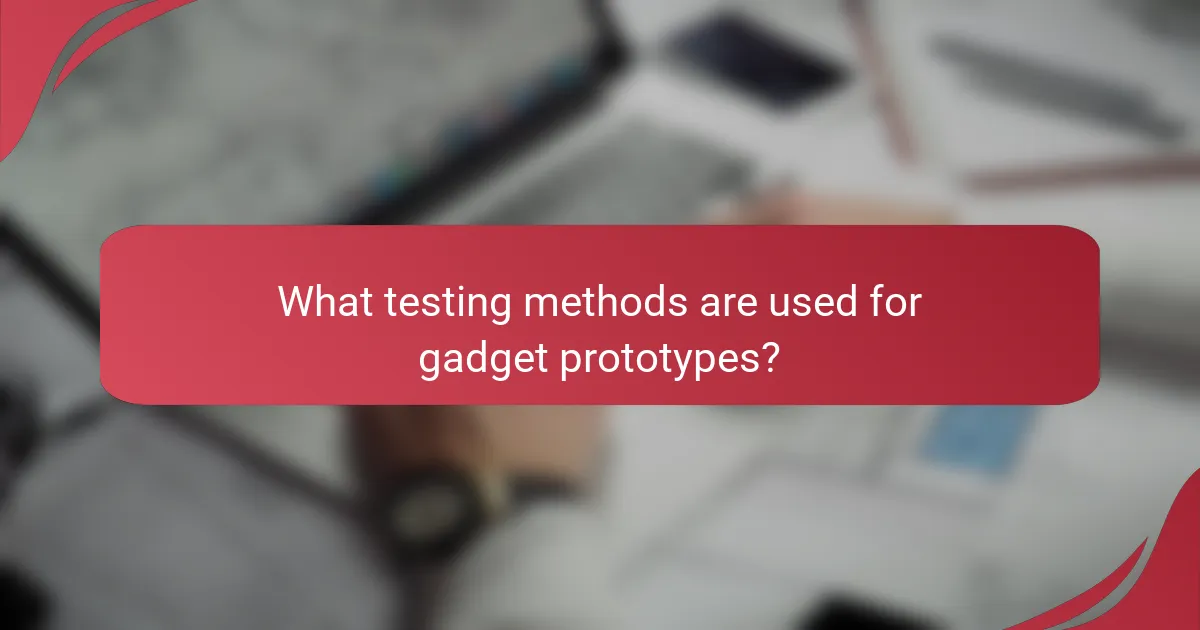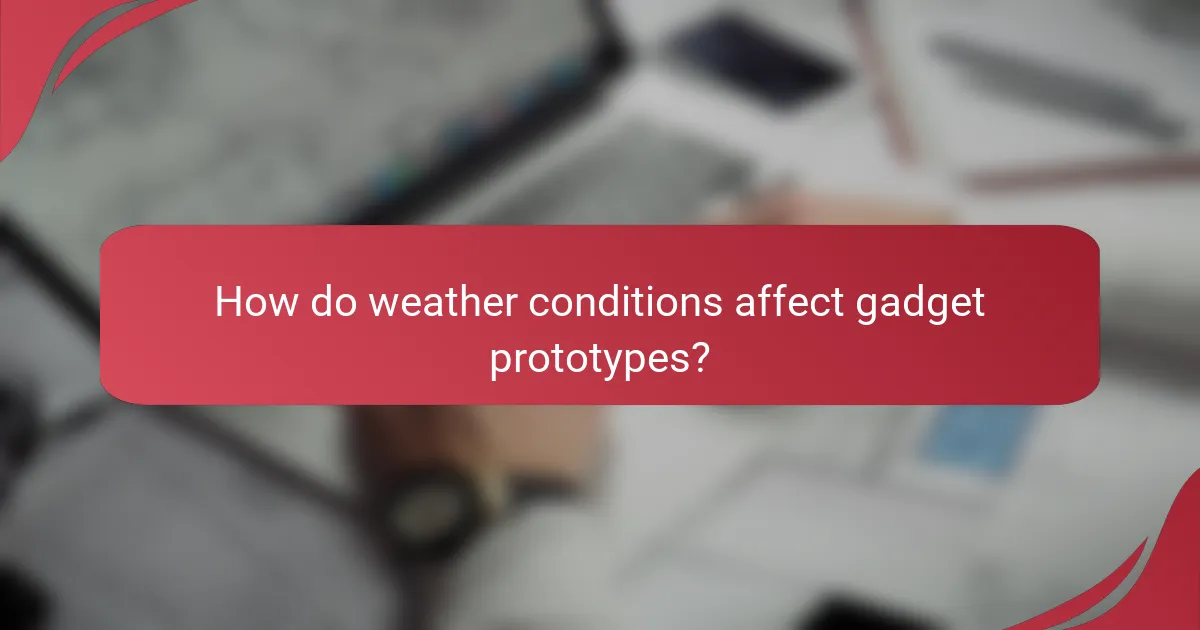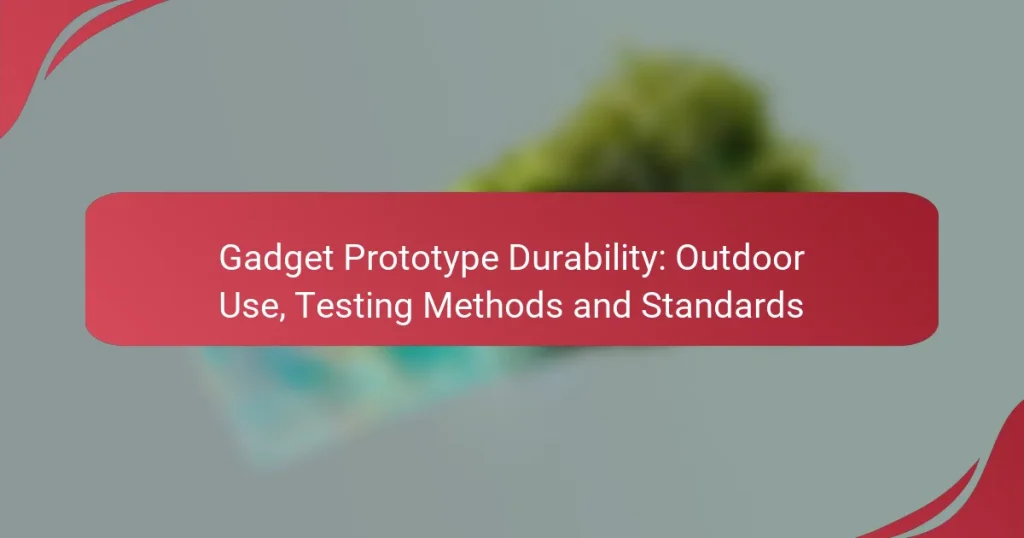Ensuring the durability of gadget prototypes for outdoor use requires careful selection of materials, protective design features, and rigorous environmental resistance testing. By employing various testing methods, manufacturers can assess performance under real-world conditions, identifying weaknesses and ensuring compliance with industry standards. These standards serve as benchmarks to enhance product resilience, reliability, and overall user satisfaction.

How to ensure gadget prototype durability for outdoor use?
To ensure gadget prototype durability for outdoor use, focus on selecting robust materials, incorporating protective design features, and conducting thorough environmental resistance testing. These steps help mitigate wear and tear from exposure to various outdoor conditions.
Material selection for outdoor durability
Choosing the right materials is crucial for outdoor durability. Look for options like high-grade plastics, aluminum, or reinforced composites that can withstand harsh weather conditions. Materials should resist UV radiation, moisture, and temperature fluctuations.
Consider the weight-to-strength ratio when selecting materials. Lightweight options may be preferable for portability, but they should not compromise structural integrity. For instance, polycarbonate is a strong yet lightweight choice for protective casings.
Design features enhancing durability
Incorporating design features that enhance durability is essential. Features such as rubberized grips, reinforced corners, and sealed ports can protect against drops and water ingress. A ruggedized design can significantly extend the lifespan of the gadget.
Additionally, consider modular designs that allow for easy repairs or replacements of damaged components. This approach not only improves durability but also reduces long-term costs associated with gadget replacement.
Environmental resistance testing
Environmental resistance testing evaluates how well a gadget withstands outdoor conditions. Common tests include exposure to extreme temperatures, humidity, dust, and water immersion. Following standards such as IP ratings can help define the level of protection against these elements.
Conducting these tests in controlled environments simulates real-world conditions. For example, an IP67 rating indicates that the device can be submerged in water up to 1 meter for 30 minutes, providing assurance of its water resistance.
Real-world usage scenarios
Understanding real-world usage scenarios is vital for assessing durability. Consider how the gadget will be used in various outdoor settings, such as hiking, camping, or construction sites. Each environment presents unique challenges that the prototype must endure.
Gather feedback from users in these scenarios to identify potential weaknesses. For instance, a gadget used in a construction site may face more impact and dust exposure than one used casually in a park. This feedback can guide further improvements in design and materials.

What testing methods are used for gadget prototypes?
Gadget prototypes undergo various testing methods to assess their durability and performance under real-world conditions. These methods help identify weaknesses and ensure that products meet industry standards before reaching consumers.
Accelerated life testing
Accelerated life testing simulates long-term usage in a shorter timeframe by exposing prototypes to extreme conditions. This method often involves elevated temperatures, humidity, and voltage to stress components and predict their lifespan. For example, a gadget might be tested for several weeks under conditions that would normally take years to replicate in everyday use.
When conducting accelerated life tests, it’s crucial to follow established protocols, such as those outlined in IEC 60068, to ensure reliable results. This testing helps manufacturers identify potential failure points early in the design process.
Drop tests and impact resistance
Drop tests evaluate how well a gadget can withstand falls and impacts, which are common in outdoor use. Prototypes are typically dropped from various heights onto different surfaces to assess their structural integrity. A common practice is to drop the device from 1.2 meters onto a concrete surface, simulating real-life accidents.
To enhance durability, manufacturers often design gadgets with shock-absorbing materials or reinforced structures. Understanding the specific use cases can help determine the appropriate drop height and impact resistance standards, such as MIL-STD-810 for military applications.
Water and dust ingress testing
Water and dust ingress testing measures a gadget’s ability to resist environmental elements, which is critical for outdoor devices. This testing typically follows the IP (Ingress Protection) rating system, where devices are subjected to water sprays, immersion, and dust exposure to evaluate their protective capabilities.
For example, an IP67 rating indicates that a device can withstand immersion in water up to 1 meter for 30 minutes and is completely dust-tight. Manufacturers should consider the intended environment of the gadget and select appropriate ingress protection levels to ensure reliability in diverse conditions.

What are the industry standards for durability testing?
Industry standards for durability testing establish benchmarks for evaluating the resilience of gadgets in various environments. These standards help manufacturers ensure their products can withstand real-world conditions, enhancing reliability and user satisfaction.
IEC 60529 for ingress protection
IEC 60529 is a standard that defines the degrees of protection provided by enclosures against the intrusion of solid objects and moisture. It uses an IP (Ingress Protection) rating system, where the first digit indicates protection against solids and the second digit against liquids. For example, an IP67 rating means the device is dust-tight and can withstand immersion in water up to 1 meter for 30 minutes.
When selecting a gadget for outdoor use, consider the IP rating carefully. Higher ratings, such as IP68, offer better protection and are suitable for harsher environments. Always verify the manufacturer’s claims against the standard to ensure compliance.
MIL-STD-810 for military standards
MIL-STD-810 is a military standard that outlines testing methods for evaluating the durability of equipment in extreme conditions. This standard includes tests for temperature, humidity, vibration, shock, and altitude, among others. Products that meet MIL-STD-810 are often designed for rugged environments, making them suitable for outdoor applications.
When assessing gadgets against this standard, look for specific test methods that apply to your intended use. For instance, if a device is expected to endure high humidity, check if it has passed the relevant MIL-STD-810 humidity tests. This ensures the product can withstand the environmental challenges it may face.
ASTM standards for material testing
ASTM standards encompass a wide range of material testing protocols that evaluate the physical and mechanical properties of materials used in gadgets. These standards help manufacturers assess factors like tensile strength, impact resistance, and thermal stability. Common ASTM standards include ASTM D638 for tensile properties and ASTM D256 for impact resistance.
When selecting materials for outdoor gadgets, consider ASTM ratings as indicators of durability. For example, materials with high impact resistance ratings are preferable for devices that may be dropped or subjected to rough handling. Always consult the relevant ASTM standards to ensure the materials meet your durability requirements.

How do weather conditions affect gadget prototypes?
Weather conditions significantly impact the durability and functionality of gadget prototypes. Factors such as UV exposure, temperature fluctuations, and moisture levels can lead to material degradation and performance issues.
Impact of UV exposure
UV exposure can cause materials to degrade over time, leading to discoloration, brittleness, and loss of structural integrity. Prototypes made from plastics and certain coatings are particularly vulnerable to UV radiation.
To mitigate UV damage, consider using UV-resistant materials or applying protective coatings. Regular testing under simulated sunlight conditions can help identify weaknesses early in the design phase.
Effects of temperature fluctuations
Temperature fluctuations can lead to expansion and contraction of materials, which may cause mechanical stress and eventual failure. Electronics are especially sensitive to extreme heat or cold, which can affect battery performance and circuit reliability.
Testing prototypes in a range of temperatures, ideally from -20°C to 60°C, can reveal potential issues. Implementing thermal management solutions, such as heat sinks or insulation, can enhance durability in varying climates.
Moisture and humidity challenges
Moisture and humidity can lead to corrosion, short-circuiting, and mold growth in gadget prototypes. Devices exposed to high humidity levels, particularly in tropical regions, are at greater risk of these issues.
To combat moisture-related problems, ensure proper sealing and use moisture-resistant materials. Conducting tests in controlled humidity environments can help assess the prototype’s resilience against water exposure.

What are the best practices for outdoor gadget testing?
Effective outdoor gadget testing requires a combination of real-world usage scenarios and controlled assessments to ensure durability and functionality. Key practices include rigorous field testing in various environments and conducting long-term durability assessments to identify potential weaknesses.
Field testing in diverse environments
Field testing should occur in a variety of outdoor conditions, such as extreme temperatures, humidity, and exposure to dust or water. This helps determine how well the gadget performs under different stresses. For example, testing a device in both a humid rainforest and a dry desert can reveal how moisture and temperature fluctuations affect its operation.
When conducting field tests, consider using a checklist to monitor performance metrics like battery life, responsiveness, and physical integrity. Engaging real users in these tests can provide valuable feedback on usability and durability that lab tests might miss.
Long-term durability assessments
Long-term durability assessments involve subjecting the gadget to extended periods of use to evaluate its lifespan and reliability. This can include simulating years of wear and tear through accelerated aging tests, which might involve repeated exposure to environmental stresses like UV light or mechanical shocks.
It’s essential to document failure points during these assessments to understand the gadget’s limits. Regularly scheduled evaluations, such as every few months, can help identify any gradual decline in performance, allowing for timely improvements before the product reaches consumers.

